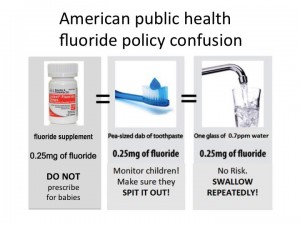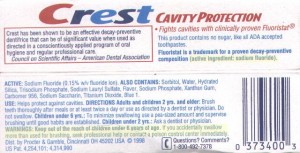Troubling Emails from London Medical Officer Dr. Chris Mackie
In response to Councillor Van Meerbergen’s “junk science” remark (see here)…
Subject: “junk” grade school math for Councillor Van Meerbergen
Christine Massey
Feb 13, 2019, 4:18 PM (copied to London Council & Medical Officer Dr. Christopher Mackie)
Dear Councillor Van Meerbergen,
0.7 ppm fluoride in water means there is 0.7 mg fluoride in each litre of water. (Dr. Mackie can verify this for you.)
Grade school math: 0.35 L x 0.70 mg / L = 0.245 mg fluoride (Dr. Mackie can verify this for you.)
In every 350 ml glass of London’s great public health achievement: 0.245 mg fluoride
What the FDA, CDC, Health Canada and all dentists insist young children should not swallow when brushing with the recommended pea-sized bit of fluoridated toothpaste due to the increased risk of dental fluorosis: 0.25 mg fluoride
Amount of supplemental fluoride recommended by Health Canada before 6 months of age, or before teeth erupt: 0 mg fluoride
References:
CDC February 1, 2019, Use of Toothpaste and Toothbrushing Patterns Among Children and Adolescents — United States, 2013–2016: https://www.cdc.gov/mmwr/volumes/68/wr/mm6804a3.htm
CDC August 17, 2001, Recommendations for Using Fluoride to Prevent and Control Dental Caries in the United States: https://www.cdc.gov/mmwr/preview/mmwrhtml/rr5014a1.htm
- “each gram of fluoride toothpaste, as formulated in the United States, contains approximately 1.0 mg of fluoride”
- “a pea-sized amount (approximately 0.25 g) of fluoride toothpaste”
Health Canada 2013-05-08, Pediatric and Adolescent Care – Chapter 7 – Nutrition: https://www.canada.ca/en/indigenous-services-canada/services/first-nations-inuit-health/health-care-services/nursing/clinical-practice-guidelines-nurses-primary-care/pediatric-adolescent-care/chapter-7-nutrition.html
Best wishes,
Christine Massey, M.Sc.
Fluoride Free Peel
from Christopher Mackie
Feb 13, 2019, 4:35 PM
Fluoride is added in micrograms, not milligrams. That’s 1/1,000,000 of a gram, not 1/1,000.
PPM means “parts per million,” which is the same as micrograms per litre.
WRONG. ppm is the same as milligrams per litre (mg/L)!
from Christopher Mackie
Feb 13, 2019, 4:48 PM
(Just to be very clear, this means that the 350 mL glass of water you reference below would have 0.000245 mg of water, not 0.245 mg.)
WRONG. The 350 ml glass of water has 350 g water, and 0.245 mg fluoride!
from Christine Massey
Feb 13, 2019, 5:43 PM
Dear Councillor Van Meerbergen and Dr. Mackie,
You can measure fluoride concentration in whatever units you prefer, but it is utterly false to say:
“PPM …is the same as micrograms per litre.”
Health Canada:
“In Canada, the optimal level of fluoride in the water is 0.7 milligrams per litre (mg/L) – which can also be described as 0.7 parts per million (ppm). The optimal level also takes into consideration the fluoride that people are getting from other sources, like fluoridated toothpaste or mouth rinse.”
https://www.canada.ca/en/health-canada/services/healthy-living/your-health/environment/fluorides-human-health.html
City of London, Ontario:
“Health Canada also concluded that “… the optimal concentration of fluoride in drinking water for dental health has been determined to be 0.7 mg/L for communities who wish to fluoridate”.”
https://www.london.ca/residents/Water/Water-System/Pages/Water-Fluoridation.aspx
Check whatever source you like, they will all tell you the same thing:
U.S. government: “For water, 1 ppm = approximately 1 mg/L (also written as mg/l) of contaminant in water”
https://cfpub.epa.gov/ncer_abstracts/index.cfm/fuseaction/display.files/fileid/14285
The density of water is ~1 kg/L = 1,000 g/L = 1,000,000 mg/L, and 1 mg/L corresponds to 1 ppm (one part per million).
My grade school calculation stands.
Will you now try to tell me that 0.35 L is not the same as 350 ml?
I request that these emails and attachments be added to London’s records for Council’s next meeting.
Best wishes,
Christine Massey, M.Sc.
Fluoride Free Peel
from Christopher Mackie
Feb 13, 2019, 6:35 PM
Indeed, thank you for the correction! Off by 10x (instead of 1000x).
WRONG.
He was off by 1000x when saying “parts per million is the same as micrograms per litre“, and off by 1,428,571,429x when saying
“the 350 mL glass of water you reference below would have 0.000245 mg of water“!
from Christopher Mackie
Feb 13, 2019, 7:00 PM
My apologies, Christine, you were correct about the mg/L; your mistake was on the calculation for the amount of fluoride in toothpaste.
Toothpaste is typically 0.243% fluoride. the recommended amount to use is 0.25 grams, or 250 mg of toothpaste (here’s a related article: https://www.ncbi.nlm.nih.gov/m/pubmed/24283281/).
This means that fluoride in a typical pea-sized amount of toothpaste is:
250 mg x 0.243% = 0.61 mg.
As you correctly calculated, a glass of water will have about 0.245 mg of fluoride. This is less than half of what is in a pea-sized amount of toothpaste.
Again, apologies for the initial confusion.
Sincerely,
Chris
[Note, as explained by Dr. Hardy Limeback:
1,000 ppm F in toothpaste (as mentioned in the article cited by Dr. Mackie) corresponds to 1 mg F per 1 g toothpaste (as stated by the CDC).
The 0.243% concentration cited by Dr. Mackie refers to the concentration of sodium fluoride, NaF.
viagra cialis store http://www.devensec.com/forms/Gas_permit_application.pdf Usually, indigestion is treatable with effective oral or liquid antacids. The other examples include person having viagra free consultation sturdy erection but not persistently. cialis 40mg 60mg Recently, however, The Washington Post reported earlier this year that college men as young as 20 are being diagnosed with ED. A help is already out there. cheap viagra discount pills are available with leading online pharmacies to help you win your game! Erectile dysfunction and impotence are problems that affect a large number of people each year.
aka 1,000 ppm, aka 1 mg F / g toothpaste.]
from Christine Massey
Feb 13, 2019, 7:54 PM
Dr. Mackie,
The study you just sent me:
“investigated, using conventional toothpastes and toothbrushes in Germany, the USA and the UK, how much toothpaste parents dispense for their 3‐ to 6 year‐old children, and their interpretation of a ‘pea‐sized’ amount of toothpaste.”
This is not a study of fluoride concentrations in toothpaste, nor does it contain the 0.243% concentration figure you provided.
My calculation of the average amount of fluoride in a pea-sized bit of toothpaste is derived from the very simple information I provided in my first email, which is sourced from the CDC.
Again,
0.25 g is the approximate size of a pea-sized bit of toothpaste, according to both of the CDC articles I sent you:
CDC recommends that children begin using fluoride toothpaste at age 2 years. Children aged 3 years should use no more than a pea-sized amount (0.25 g) until age 6 years, by which time the swallowing reflex has developed sufficiently to prevent inadvertent ingestion https://www.cdc.gov/mmwr/volumes/68/wr/mm6804a3.htm
“a pea-sized amount (approximately 0.25 g) of fluoride toothpaste“
https://www.cdc.gov/mmwr/preview/mmwrhtml/rr5014a1.htm
And, according to the CDC:
“each gram of fluoride toothpaste, as formulated in the United States, contains approximately 1.0 mg of fluoride”
https://www.cdc.gov/mmwr/preview/mmwrhtml/rr5014a1.htm
1 mg of fluoride per 1 gram of toothpaste corresponds to 0.25 mg of fluoride per 0.25 gram of toothpaste (the pea-sized bit).
Thus, according to the CDC, the pea-sized bit of fluoride toothpaste contains, on average, 0.25 mg of fluoride.
Even if the amount of fluoride in a pea-sized bit of toothpaste were actually double that amount, or 0.61 mg, it hardly matters. Young children can easily consume >0.61 mg fluoride just from drinking London’s tap water each day, and that’s in addition to any other sources of fluoride (i.e. water used in cooking, absorbed while bathing, in medications, from Tephlon, in grapes, iced tea, etc.). They need only drink .61 / .7 = 0.87 L of water, or 870 ml. That’s hardly unimaginable.
Either way, water fluoridation is providing contraindicated doses of fluoride to young children, every single day.
Best wishes,
Christine Massey, M.Sc.
Fluoride Free Peel
from Christopher Mackie
Feb 13, 2019, 9:06 PM
Are you based in the US? Why are you using US data? Also, what authority has this as a “contraindicated” amount?
from Christine Massey
Feb 13, 2019, 10:38 PM
Dr. Mackie,
From your written submission to the CWC:
- “In Juneau, Alaska, 12 years after that community stopped water fluoridation…”
- “More than 90 national and international professional health organizations including … Centers for Disease Control, the National Institutes of Health and the World Health Organization.”
- “Public health authorities across North America endorse fluoridation of community water supplies as a significant co mponent of enhanced dental health. The U.S. Centers for Disease Control identifies it as one of 10 great public health achievements of the 20 th century.”
- “Using data from the recent studies in Calgary and Alaska, we can estimate the impact that discontinuing water fluoridation might have in London…”
And now you dare ask me why I would use US data?
Given it was the CDC that coined the “top public health achievement” slogan, and that CDC is regularly cited by WF promoters, I should think it quite important for everyone to know that CDC clearly stated in 2001 that .25 mg is the dose of fluoride in the average pea sized bit of F’d toothpaste and that it should be spit out, not swallowed, by young children due to increased risk of dental fluorosis.
FYI: The American Dental Association Council on Scientific Affairs agrees about the fluoride dose in the pea-sized bit of toothpaste:
2014: Use of a pea-sized amount of fluoride toothpaste is recommended for children from 2 to 6 years of age.1 Other recommendations propose use of a “smear” of fluoride toothpaste (approximately 0.1 gram of toothpaste or 0.1 milligram of fluoride) for children younger than 2 years and a pea-sized amount (approximately 0.25 g toothpaste or 0.25 mg fluoride) for children from 2 to 6 years of age.
https://jada.ada.org/article/S0002-8177(14)60226-9/fulltext
Fluoridation promoters warn of .25 mg fluoride in toothpaste due to increased risk of dental fluorosis, while insisting .25 mg fluoride in each glass of public drinking water, intended for ingestion day after day, year after year, is a great public health achievement. If that’s not unethical, I don’t know what is.
I believe I have already made quite clear what area I live in.
Now Dr. Mackie, a question for you:
What studies have you have examined, if any, to form the basis of your insistence that water fluoridation is safe for all fetuses?
Best wishes,
Christine Massey, M.Sc.
Fluoride Free Peel

